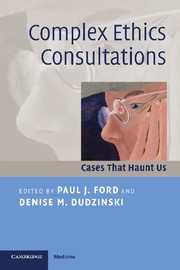Book contents
- Frontmatter
- Contents
- List of contributors
- Foreword
- Acknowledgments
- Introduction: Live and learn: courage, honesty, and vulnerability
- Part I Starting at the beginning: prenatal and neonatal issues
- Part II The most vulnerable of us: pediatrics
- 5 She was the life of the party
- 6 The sound of chains
- 7 Susie's voice
- 8 Access to an infant's family: lingering effects of not talking with parents
- Part III Diversity of desires and limits of liberty: psychiatric and psychological issues
- Part IV Withholding therapy with a twist
- Part V The unspeakable/unassailable: religious and cultural beliefs
- Part VI Human guinea pigs and miracles: clinical innovations and unorthodox treatment
- Part VII The big picture: organizational issues
- Conclusions, educational activities, and references
- Index
6 - The sound of chains
Published online by Cambridge University Press: 03 May 2010
- Frontmatter
- Contents
- List of contributors
- Foreword
- Acknowledgments
- Introduction: Live and learn: courage, honesty, and vulnerability
- Part I Starting at the beginning: prenatal and neonatal issues
- Part II The most vulnerable of us: pediatrics
- 5 She was the life of the party
- 6 The sound of chains
- 7 Susie's voice
- 8 Access to an infant's family: lingering effects of not talking with parents
- Part III Diversity of desires and limits of liberty: psychiatric and psychological issues
- Part IV Withholding therapy with a twist
- Part V The unspeakable/unassailable: religious and cultural beliefs
- Part VI Human guinea pigs and miracles: clinical innovations and unorthodox treatment
- Part VII The big picture: organizational issues
- Conclusions, educational activities, and references
- Index
Summary
Case narrative
It was an anomalous case from beginning to end. The request came from social work, which is not strange in and of itself. It was the nature of the request, rather than its source, that was unusual. Should the mother of a patient be allowed to visit her child? Of course, additional details followed: The child was a shaken baby, and the mother was a suspect. From my phone conversation I inferred that many people on the team felt the answer should be “No.”
My gut reaction was that a mother should be allowed to visit her child unless there is solid evidence that it would endanger the child. Unfortunately, in this case, the harm had already been done. Furthermore, even if she were the one who had harmed the child, it was most likely due to a momentary loss of control – terrible yes, inexcusable yes, but unlikely to happen again in a controlled and supervised environment.
I try not to give my “gut” reaction over the phone. Sometimes I know it is a well-justified opinion, and a slew of articles come to mind that could serve as references for the eventual consult note. However, I reserve judgment until I know enough of the individual circumstances to know whether the references or paradigms influencing my opinion are appropriate to the case.
The situation became more complex and confusing than I realized after I talked to the social worker. The mother and her boyfriend said they were both at home, and each said that neither had harmed the baby.
- Type
- Chapter
- Information
- Complex Ethics ConsultationsCases that Haunt Us, pp. 52 - 58Publisher: Cambridge University PressPrint publication year: 2008



